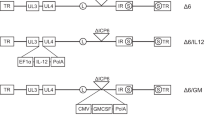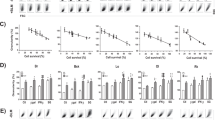Abstract
Suicide gene therapy using the herpes simplex virus thymidine kinase/ganciclovir (HSV-tk/GCV) system is a well-characterized tool for cancer gene therapy; however, it does not yet exhibit sufficient efficacy to cure patients of malignancies. We have reported that adenovirally delivered monocyte chemoattractant protein (MCP)-1 augmented the antitumor effects of the HSV-tk/GCV system in an athymic nude mouse model. The current study, which uses an immunocompetent mouse model of colon cancer, was designed to evaluate the antitumor effects of MCP-1 gene delivery in conjunction with this suicide gene therapy system. Subcutaneous tumor foci were directly transduced with both recombinant adenoviruses (rAds) expressing an HSV-tk gene and either of the MCP-1, CD80 and LacZ genes, followed by GCV administration. The growth of tumors was markedly suppressed by codelivery of HSV-tk and MCP-1 genes, which was exclusively associated with the recruitment of monocytes/macrophages, T helper 1 (Th1) cytokine gene expression and cytotoxic activity of the splenocytes. Furthermore, the antitumor effects were more efficient than that obtained by the combination of HSV-tk and CD80 genes. These results suggest an immunomodulatory effect of MCP-1 in the context of suicide gene therapy of colon cancer via orchestration of innate and acquired immune responses.
This is a preview of subscription content, access via your institution
Access options
Subscribe to this journal
Receive 12 print issues and online access
$259.00 per year
only $21.58 per issue
Buy this article
- Purchase on Springer Link
- Instant access to full article PDF
Prices may be subject to local taxes which are calculated during checkout









Similar content being viewed by others
References
Kudo S, Kashida H, Tamura T, Kogure E, Imai Y, Yamano H et al. Colonoscopic diagnosis and management of nonpolypoid early colorectal cancer. World J Surg 2000; 24: 1081–1090.
Ambiru S, Miyazaki M, Ito H, Nakagawa K, Shimizu H, Kato A et al. Resection of hepatic and pulmonary metastases in patients with colorectal carcinoma. Cancer 1998; 82: 274–278.
Van Tuyl A, Ghosh BC . Radiofrequency ablation of metastatic liver tumor. J Surg Oncol 2000; 73: 234–235.
Andre T, Boni C, Mounedji-Boudiaf L, Navarro M, Tabernero J, Hickish T et al. Multicenter International Study of Oxaliplatin/5-Fluorouracil/Leucovorin in the Adjuvant Treatment of Colon Cancer (MOSAIC) Investigators. Oxaliplatin, fluorouracil, and leucovorin as adjuvant treatment for colon cancer. N Engl J Med 2004; 350: 2343–2351.
Culver KW, Ram Z, Wallbridge S, Ishii H, Oldfield EH, Blaese RM et al. In vivo gene transfer with retroviral vector-producer cells for treatment of experimental brain tumors. Science 1992; 256: 1550–1552.
Wu JK, Cano WG, Meylaerts SA, Qi P, Vrionis F, Cherington V . Bystander tumoricidal effect in the treatment of experimental brain tumors. Neurosurgery 1994; 35: 1094–1102.
Elshami AA, Saavedra A, Zhang H, Kucharczuk JC, Spray DC, Fishman GI et al. Gap junctions play a role in the ‘bystander effect’ of the herpes simplex virus thymidine kinase/ganciclovir system in vitro. Gene Therapy 1996; 3: 85–92.
Ramesh R, Marrogi AJ, Munshi A, Abboud CN, Freeman SM . In vivo analysis of the ‘bystander effect’: a cytokine cascade. Exp Hematol 1996; 24: 829–838.
Freeman SM, Ramesh R, Shastri M, Munshi A, Jensen AK, Marrogi AJ . The role of cytokines in mediating the bystander effect using HSV-TK xenogeneic cells. Cancer Lett 1995; 92: 167–174.
Matsushima K, Larsen CG, DuBois GC, Oppenheim JJ . Purification and characterization of a novel monocyte chemotactic and activating factor produced by a human myelomonocytic cell line. J Exp Med 1989; 169: 1485–1490.
Rollins BJ, Sunday ME . Suppression of tumor formation in vivo by expression of the JE gene in malignant cells. Mol Cell Biol 1991; 11: 3125–3131.
Carr MW, Roth SJ, Luther E, Rose SS, Springer TA . Monocyte chemoattractant protein 1 acts as a T-lymphocyte chemoattractant. Proc Natl Acad Sci USA 1994; 91: 3652–3656.
Loetscher P, Seitz M, Clark-Lewis I, Baggiolini M, Moser B . Monocyte chemotactic proteins MCP-1, MCP-2, and MCP-3 are major attractants for human CD4+ and CD8+ T lymphocytes. FASEB J 1994; 8: 1055–1060.
Hirose K, Hakozaki M, Nyunoya Y, Kobayashi Y, Matsushita K, Takenouchi T et al. Chemokine gene transfection into tumour cells reduced tumorigenicity in nude mice in association with neutrophilic infiltration. Br J Cancer 1995; 72: 708–714.
Huang S, Xie K, Singh RK, Gutman M, Bar-Eli M . Suppression of tumor growth and metastasis of murine renal adenocarcinoma by syngeneic fibroblasts genetically engineered to secrete the JE/MCP-1 cytokine. J Interferon Cytokine Res 1995; 15: 655–665.
Sakai Y, Kaneko S, Nakamoto Y, Kagaya T, Mukaida N, Kobayashi K . Enhanced anti-tumor effects of herpes simplex virus thymidine kinase/ganciclovir system by codelivering monocyte chemoattractant protein-1 in hepatocellular carcinoma. Cancer Gene Ther 2001; 8: 695–704.
Tsuchiyama T, Kaneko S, Nakamoto Y, Sakai Y, Honda M, Mukaida N et al. Enhanced antitumor effects of a bicistronic adenovirus vector expressing both herpes simplex virus thymidine kinase and monocyte chemoattractant protein-1 against hepatocellular carcinoma. Cancer Gene Ther 2003; 10: 260–269.
Kubin M, Kamoun M, Trinchieri G . Interleukin 12 synergizes with B7/CD28 interaction in inducing efficient proliferation and cytokine production of human T cells. J Exp Med 1994; 180: 211–222.
June CH, Bluestone JA, Nadler LM, Thompson CB . The B7 and CD28 receptor families. Immunol Today 1994; 15: 321–331.
Chen L, Ashe S, Brady WA, Hellstrom I, Hellstrom KE, Ledbetter JA et al. Costimulation of antitumor immunity by the B7 counterreceptor for the T lymphocyte molecules CD28 and CTLA-4. Cell 1992; 71: 1093–1102.
Townsend SE, Allison JP . Tumor rejection after direct costimulation of CD8+ T cells by B7-transfected melanoma cells. Science 1993; 259: 368–370.
Yasumoto K, Mukaida N, Harada A, Kuno K, Akiyama M, Nakashima E et al. Molecular analysis of the cytokine network involved in cachexia in colon 26 adenocarcinoma-bearing mice. Cancer Res 1995; 55: 921–927.
Kanegae Y, Lee G, Sato Y, Tanaka M, Nakai M, Sakaki T et al. Efficient gene activation in mammalian cells by using recombinant adenovirus expressing site-specific Cre recombinase. Nucleic Acids Res 1995; 23: 3816–3821.
Miyake S, Makimura M, Kanegae Y, Harada S, Sato Y, Takamori K et al. Efficient generation of recombinant adenoviruses using adenovirus DNA-terminal protein complex and a cosmid bearing the full-length virus genome. Proc Natl Acad Sci USA 1996; 93: 1320–1324.
Sato Y, Tanaka K, Lee G, Kanegae Y, Sakai Y, Kaneko S et al. Enhanced and specific gene expression via tissue-specific production of Cre recombinase using adenovirus vector. Biochem Biophys Res Commun 1998; 244: 455–462.
Precious B, Russell WC . A Practical Approach. In: Marphy BWJ (ed.), Virology. Oxford: IPL Press, 1985, pp. 193–206.
Kanegae Y, Makimura M, Saito I . A simple and efficient method for purification of infectious recombinant adenovirus. Jpn J Med Sci Biol 1994; 47: 157–166.
Ko Y, Mukaida N, Panyutich A, Voitenok NN, Matsushima K, Kawai T et al. A sensitive enzyme-linked immunosorbent assay for human interleukin-8. J Immunol Methods 1992; 149: 227–235.
Pollard K, Lunny D, Holgate CS, Jackson P, Bird CC . Fixation, processing, and immunochemical reagent effects on preservation of T-lymphocyte surface membrane antigens in paraffin-embedded tissue. J Histochem Cytochem 1987; 35: 1329–1338.
Simmons CP, Mastroeni P, Fowler R, Ghaem-maghami M, Lycke N, Pizza M et al. MHC class I-restricted cytotoxic lymphocyte responses induced by enterotoxin-based mucosal adjuvants. J Immunol 1999; 163: 6502–6510.
Chen SH, Chen XH, Wang Y, Kosai K, Finegold MJ, Rich SS et al. Combination gene therapy for liver metastasis of colon carcinoma in vivo. Proc Natl Acad Sci USA 1995; 92: 2577–2581.
Chen SH, Kosai K, Xu B, Pham-Nguyen K, Contant C, Finegold MJ et al. Combination suicide and cytokine gene therapy for hepatic metastases of colon carcinoma: sustained antitumor immunity prolongs animal survival. Cancer Res 1996; 56: 3758–3762.
Caruso M, Pham-Nguyen K, Kwong YL, Xu B, Kosai KI, Finegold M et al. Adenovirus-mediated interleukin-12 gene therapy for metastatic colon carcinoma. Proc Natl Acad Sci USA 1996; 93: 11302–11306.
Benedetti S, Dimeco F, Pollo B, Cirenei N, Colombo BM, Bruzzone MG et al. Limited efficacy of the HSV-TK/GCV system for gene therapy of malignant gliomas and perspectives for the combined transduction of the interleukin-4 gene. Hum Gene Ther 1997; 8: 1345–1353.
Moriuchi S, Oligino T, Krisky D, Marconi P, Fink D, Cohen J et al. Enhanced tumor cell killing in the presence of ganciclovir by herpes simplex virus type 1 vector-directed coexpression of human tumor necrosis factor-alpha and herpes simplex virus thymidine kinase. Cancer Res 1998; 58: 5731–5737.
Whartenby KA, Darnowski JW, Freeman SM, Yurasha K, Calabresi P . Recombinant interferon alpha2a synergistically enhances ganciclovir-mediated tumor cell killing in the herpes simplex virus thymidine kinase system. Cancer Gene Ther 1999; 6: 402–408.
Nesbit M, Schaider H, Miller TH, Herlyn M . Low-level monocyte chemoattractant protein-1 stimulation of monocytes leads to tumor formation in nontumorigenic melanoma cells. J Immunol Methods 2001; 166: 6483–6490.
Huang S, Singh RK, Xie K, Gutman M, Berry KK, Bucana CD et al. Expression of the JE/MCP-1 gene suppresses metastatic potential in murine colon carcinoma cells. Cancer Immunol Immunother 1994; 39: 231–238.
Fukumura D, Salehi HA, Witwer B, Tuma RF, Melder RJ, Jain RK . Tumor necrosis factor alpha-induced leukocyte adhesion in normal and tumor vessels: effect of tumor type, transplantation site, and host strain. Cancer Res 1995; 55: 4824–4829.
Schwartz RH . Costimulation of T lymphocytes: the role of CD28, CTLA-4, and B7/BB1 in interleukin-2 production and immunotherapy. Cell 1992; 71: 1065–1068.
Linsley PS, Ledbetter JA . The role of the CD28 receptor during T cell responses to antigen. Annu Rev Immunol 1993; 11: 191–212.
Tatsumi T, Takehara T, Katayama K, Mochizuki K, Yamamoto M, Kanto T et al. Expression of costimulatory molecules B7-1 (CD80) and B7-2 (CD86) on human hepatocellular carcinoma. Hepatology 1997; 25: 1108–1114.
Tatsumi T, Takehara T, Kanto T, Kuzushita N, Ito A, Kasahara A et al. B7-1 (CD80)-gene transfer combined with interleukin-12 administration elicits protective and therapeutic immunity against mouse hepatocellular carcinoma. Hepatology 1999; 30: 422–429.
Ramesh R, Munshi A, Abboud CN, Marrogi AJ, Freeman SM . Expression of costimulatory molecules: B7 and ICAM up-regulation after treatment with a suicide gene. Cancer Gene Ther 1996; 3: 373–384.
Choti MA, Bulkley GB . Management of hepatic metastases. Liver Transpl Surg 1999; 5: 65–80.
Gerolami R, Cardoso J, Lewin M, Bralet MP, Sa Cunha A, Clement O et al. Evaluation of HSV-tk gene therapy in a rat model of chemically induced hepatocellular carcinoma by intratumoral and intrahepatic artery routes. Cancer Res 2000; 60: 993–1001.
Marshall E . Gene therapy death prompts review of adenovirus vector [news]. Science 1999; 286: 2244–2245.
Author information
Authors and Affiliations
Corresponding author
Rights and permissions
About this article
Cite this article
Kagaya, T., Nakamoto, Y., Sakai, Y. et al. Monocyte chemoattractant protein-1 gene delivery enhances antitumor effects of herpes simplex virus thymidine kinase/ganciclovir system in a model of colon cancer. Cancer Gene Ther 13, 357–366 (2006). https://doi.org/10.1038/sj.cgt.7700908
Received:
Revised:
Accepted:
Published:
Issue Date:
DOI: https://doi.org/10.1038/sj.cgt.7700908
Keywords
This article is cited by
-
Membrane-bound form of monocyte chemoattractant protein-1 enhances antitumor effects of suicide gene therapy in a model of hepatocellular carcinoma
Cancer Gene Therapy (2012)
-
Molecular mechanisms of liver metastasis
International Journal of Clinical Oncology (2011)
-
Combination effect of oncolytic adenovirus therapy and herpes simplex virus thymidine kinase/ganciclovir in hepatic carcinoma animal models
Acta Pharmacologica Sinica (2009)
-
Targeting tumor-associated macrophages in an experimental glioma model with a recombinant immunotoxin to folate receptor β
Cancer Immunology, Immunotherapy (2009)
-
HSV-tk/GCV gene therapy mediated by EBV-LMP1 for EBV-associated cancer
Journal of Experimental & Clinical Cancer Research (2008)



